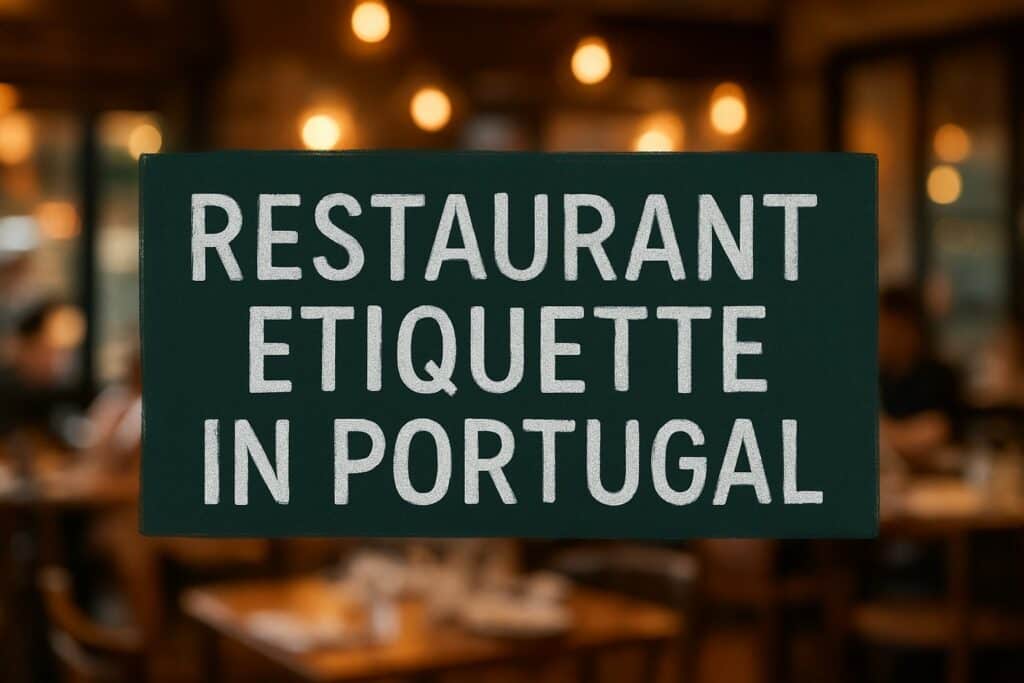
So you have arrived in Portugal and will have a meal out in a restaurant, what can go wrong? Well, not a lot, but some things can. Of course, it will not be a big deal, but there are some situations where it’s better if you know what to expect. Some of these situations are more common in Europe, so European travellers won’t notice too many things “out of place”, but American travellers may.
One of the things that is fairly different in Portugal is that Pets are generally not allowed inside the restaurants and kids (any age) are welcomed everywhere. While travellers many times don’t travel with pets, they often travel with kids, and you shouldn’t be afraid of enjoying a nice meal with your family, kids included. Many, if not all restaurants will have a toddler seat to attach or put near the table, so even the younger ones can sit with you. As for the pets, many locations welcome them outside, in terraces, but not always inside. But if you need, just ask at the door or when booking to check the precise situation.
When you arrive, do you see yourself to a table or you wait to be seated?
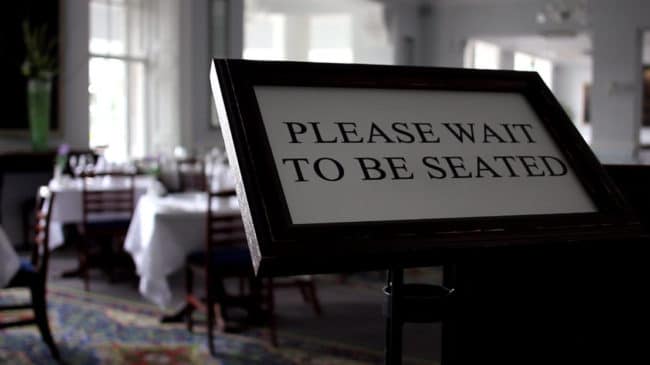
Like in many situations, it depends. Generally, in pastry shops and small cafés you can just occupy a free table and don’t have to wait for someone to point a seat to you. Just make sure someone sees you or that it is not a pre-payment place, or you may end up waiting “forever”. In Restaurants, on the other hand, it is quite normal to have a “Please Wait to Be Seated” sign, or “Aguarde Por Favor” and someone will indicate a table to you or let you choose. If they let you choose and your party is, for example, two people, if possible, don’t use a 4 seat table, in other words try to use a table adequate to your party size.
They bring starters without anyone asking? Are they free?
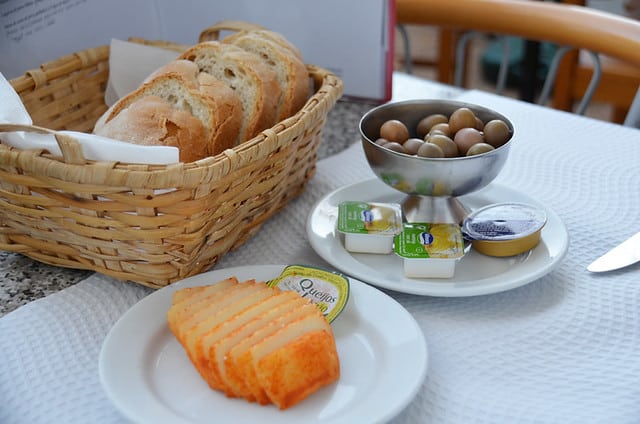
It’s good manners in Portugal to put starters on the table in a restaurant as soon as you sit down. Portuguese would even find it a bit odd if not rude if this does not happen! But the fact is that everyone should ask before bringing anything and more and more restaurants do it instead of just assuming you want. But know that you don’t have to eat the starters: if they stay untouched and you send them back you won’t pay for them. So the rule is, anything you don’t want just send it back and it won’t be a problem. Portuguese people always like to have something on the table, even if it’s just olives or bread, but everything is optional and nothing is free.
The standard “entradas” normally comprises a basket of fresh bread (pão), a small plate of marinated olives (azeitonas) and a plate with packaged tuna and sardine patés, butter and maybe cheese or chouriço. Often, the cost is low, amounting to no more than a couple of euros on your bill (except things like curated cheese, sausages or cold cuts like “chouriço”). In some restaurants, along with the standard fare, you may also receive a plate of smoked ham (presunto), octopus salad (salada de polvo) or shrimp (camarões), and will run you around 4-6 euros each. So if you came on a budget, you may want to ask the server to take them away at the beginning, to avoid any problems. And while we’re in the theme of “entradas”, I know we tend to use knife and fork for everything, but don’t do it for olives. I see a lot of people serving the olives to their plates and going at them with a fork, which can be a nice exercise but it’s not needed. Those we eat with our hands, from our plate or straight from the olive dish, so no need to overthink that.
Soup at every meal?
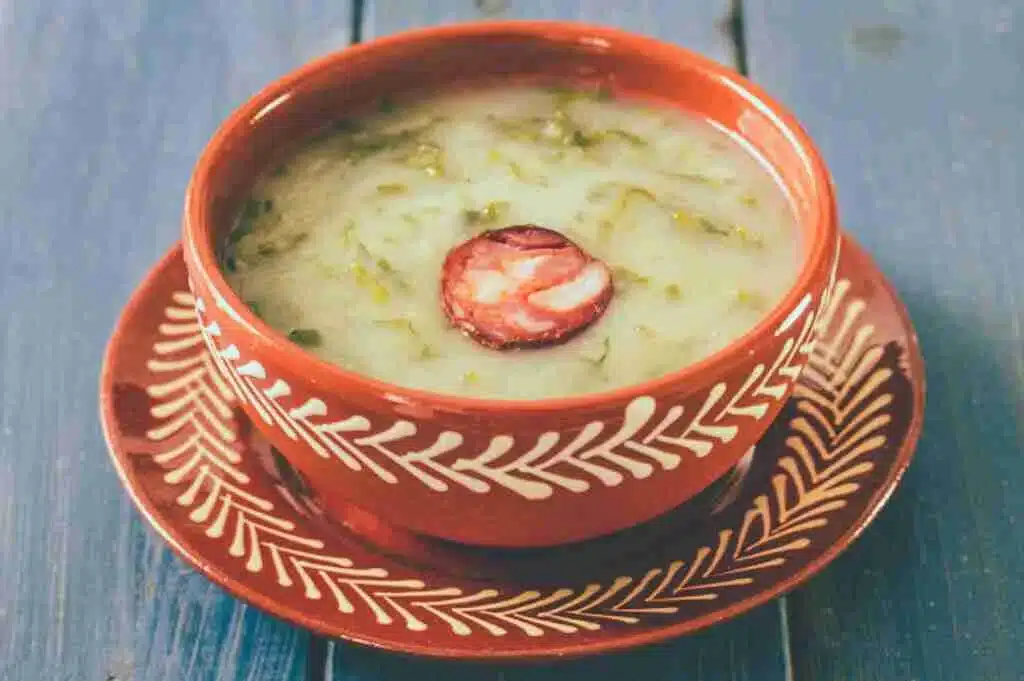
Well, the Portuguese are famous for their soups, that’s true, and many of us, do eat it at always, i mean, at EVERY.SINGLE.MEAL, rain or shine, winter or summer. But you don’t have to. Just know that all restaurants will have at least one soup and that most times when you ask they’ll say “vegetable soup” (creme de legumes). This is a generic name for most soups in Portugal that can have a few vegetables and not always the same. If you ask what it has, it is probable that they won’t know precisely but normally they are made with onions, potatoes or pumpkin, carrots, zuchinni or a cabbage and may have some spinach (Sopa de Espinafres), leek (Sopa de Alho Francês), watercress (Sopa de Agrião), etc etc. Some traditional soups like the Caldo Verde in the picture have their own names and are not in this broad list of vegetable soups.
What do you mean you’re not open? What are the meal times?
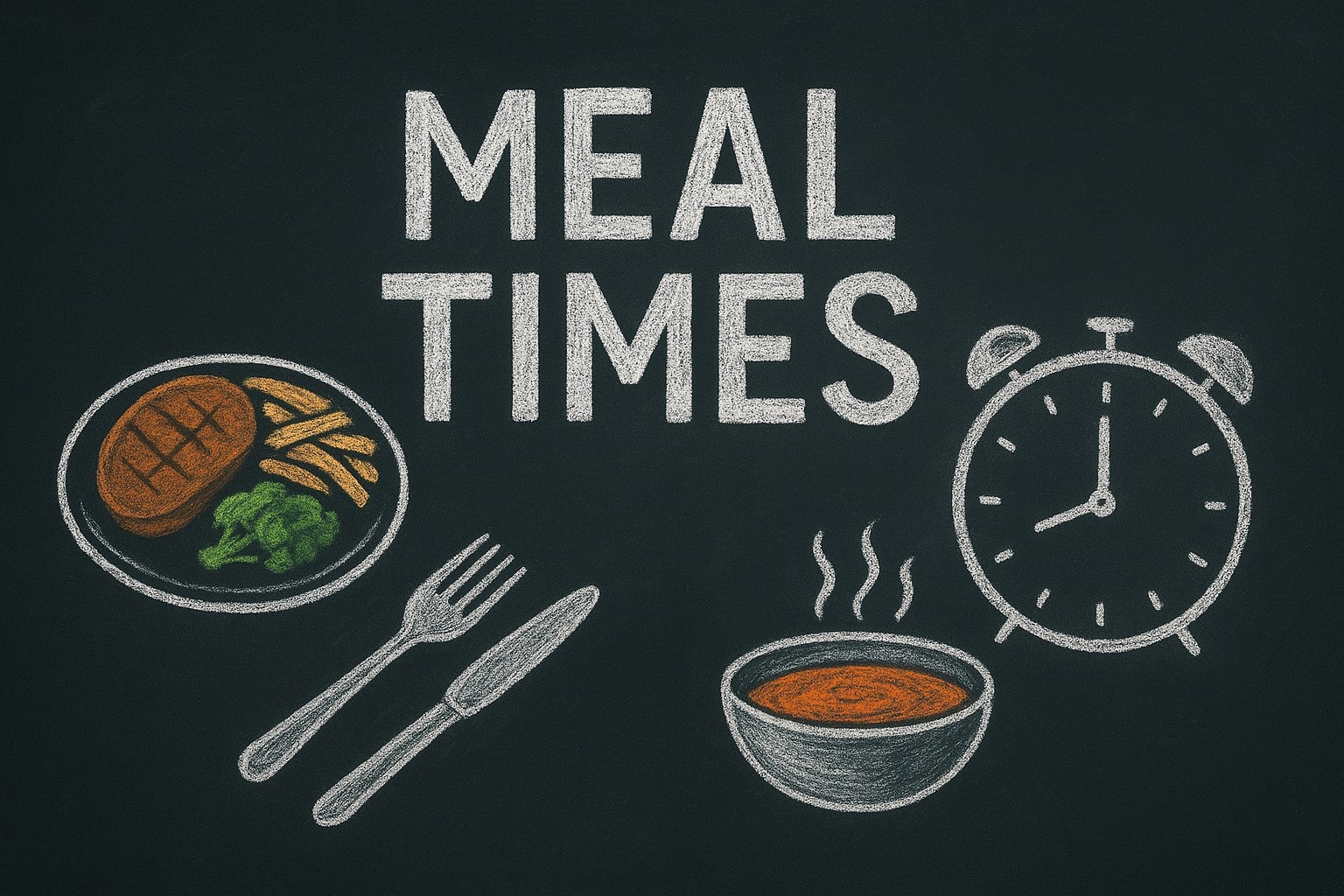
This is one thing that normally puzzles many visitors, but indeed if you want to dine at 6pm you may encounter some difficulties. Of course, more recently, with the growing number of visitors, in the more touristy areas, we see many places that are open continuously from the morning to the late evening or night, but outside of big centers and in less touristy places it will not be rare to find restaurants closed before noon and again closed between 4pm and 7pm. Meal times are normally from 12.30pm to 2.30pm for lunch (although nobody takes 2 hours, more like 1 hour between these times), and 7pm to 10pm for dinner. You may find strange people eating at 10pm but I assure you that in a summer weekend it will be quite common to see people coming in for dinner and then a night out at that time, when others (and most specially tourists) have already left and are going to bed.
What about booking? As a general rule of thumb, since normally you don’t know the places and when you’re really set on going to that particular place, I always advise people to book. This way is guaranteed. If your group is larger, or if you go on a weekend or a special day that you may not be aware of, and it is frustrating to find you have to wait a long time or go somewhere else. Nevertheless, it is true that if you go quite early (like a 7pm for dinner), chances are that the place is empty, but you know that Portugal is a very popular location now and more tourists may have the same idea. So, it normally doesn’t cost a thing, the hotel can do it for you, and many times the places speak English so, don’t risk it and book. There are some places, though, that now start to charge you for a booking. This is not the norm but it is becoming more usual, the problem is that many many people book 3 or 4 places and then they don’t cancel the ones they are not going. So a restaurant can end up having a full room of reservations and refusing patrons and then nobody shows. Please don’t be this tourist; be respectful of other people’s work and call to cancel or honor your reservations.
Is there an all inclusive menu of sorts in restaurants?
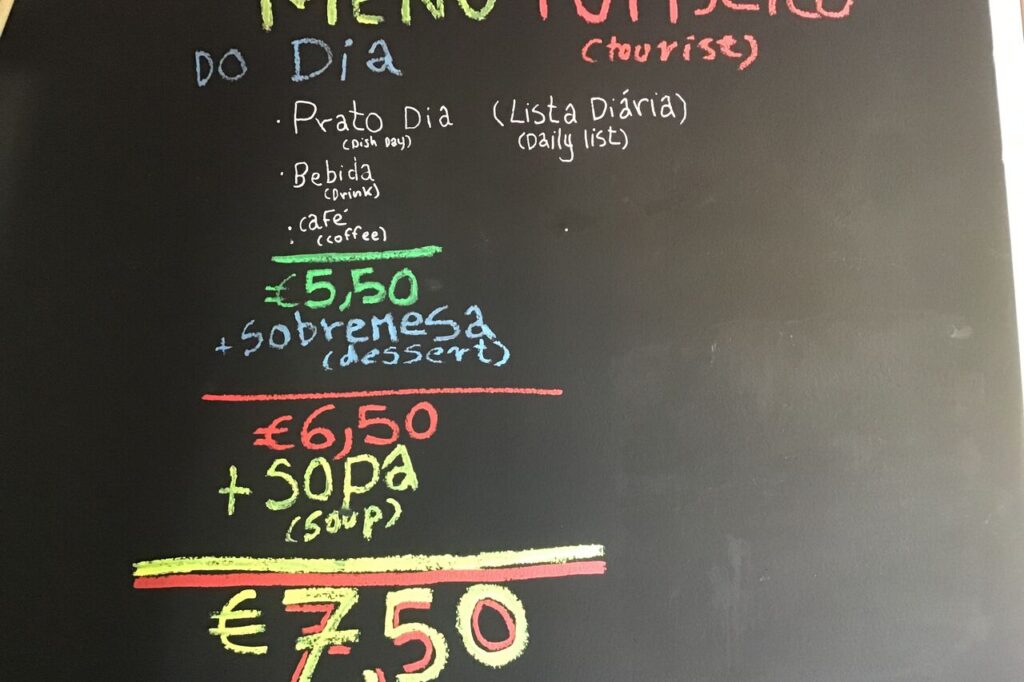
In many cases, yes. While you shouldn’t expect it in the large touristy centres and at dinner, many times at lunch, restaurants have what we call “Menu” or “Diária” (in the north). This normally is a fixed price menu with an appetizer, usually bread and olives, a couple of options for main dish, normally one fish and one meat, soup or dessert and coffee. These set menus can range from 6/7€ to 11/12€ (more common) or up to 14/15€ in some places in Lisbon, depending on the place and the dish itself, but it’s a more economical way of doing your meals instead of “a la carte”, where you may get more but you end up paying a few euros more per person. So it basically depends on what you want and what you eat. Be sure to ask if you can’t see that written up at the entrance.
I went to a seafood place and there was nothing but shellfish. Where did I go wrong?
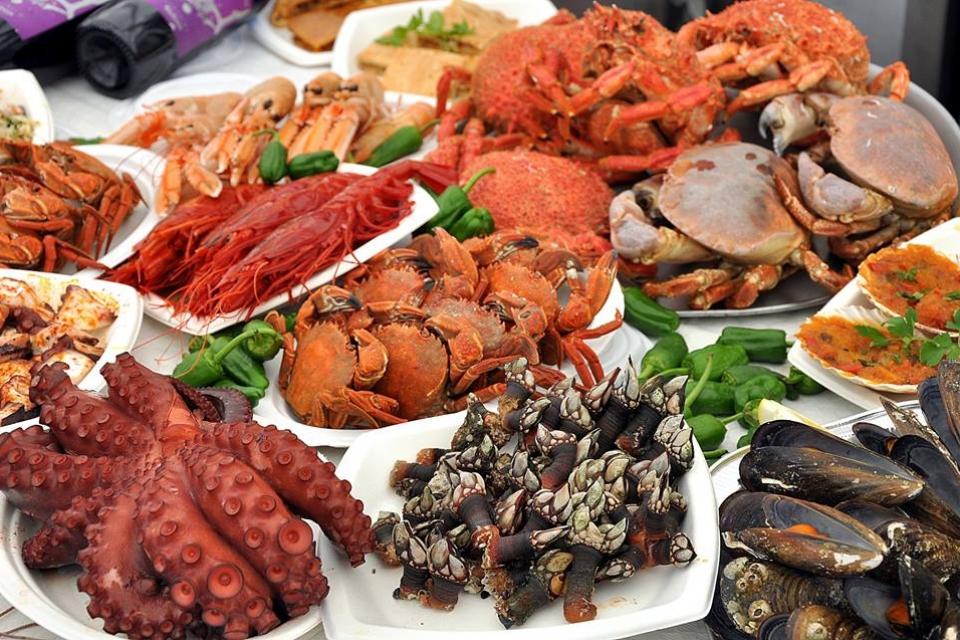
There was nothing wrong, but it’s true that in Portugal you can find a category of restaurants that will serve you almost only shellfish. They’re called “Cervejarias” or “Marisqueiras” (although Marisqueiras can also be restaurants with a shellfish tank) which literally mean beer place or shellfish place. They are restaurants but they don’t serve elaborate meals, instead they will do lobster, crab, shrimp, clams, etc like no-one else, some toasted bread and butter and you may even get a steak sandwich or a fried steak but not much more. And did I mention beer? Yes, beer, lots of. Mainly coming from one of the two big Portuguese brands and the bigger/better places will have some Stout or Weiss on tap along with the normal lager. The perfect place to watch Sunday football (I mean, soccer).
All of that is just for me?
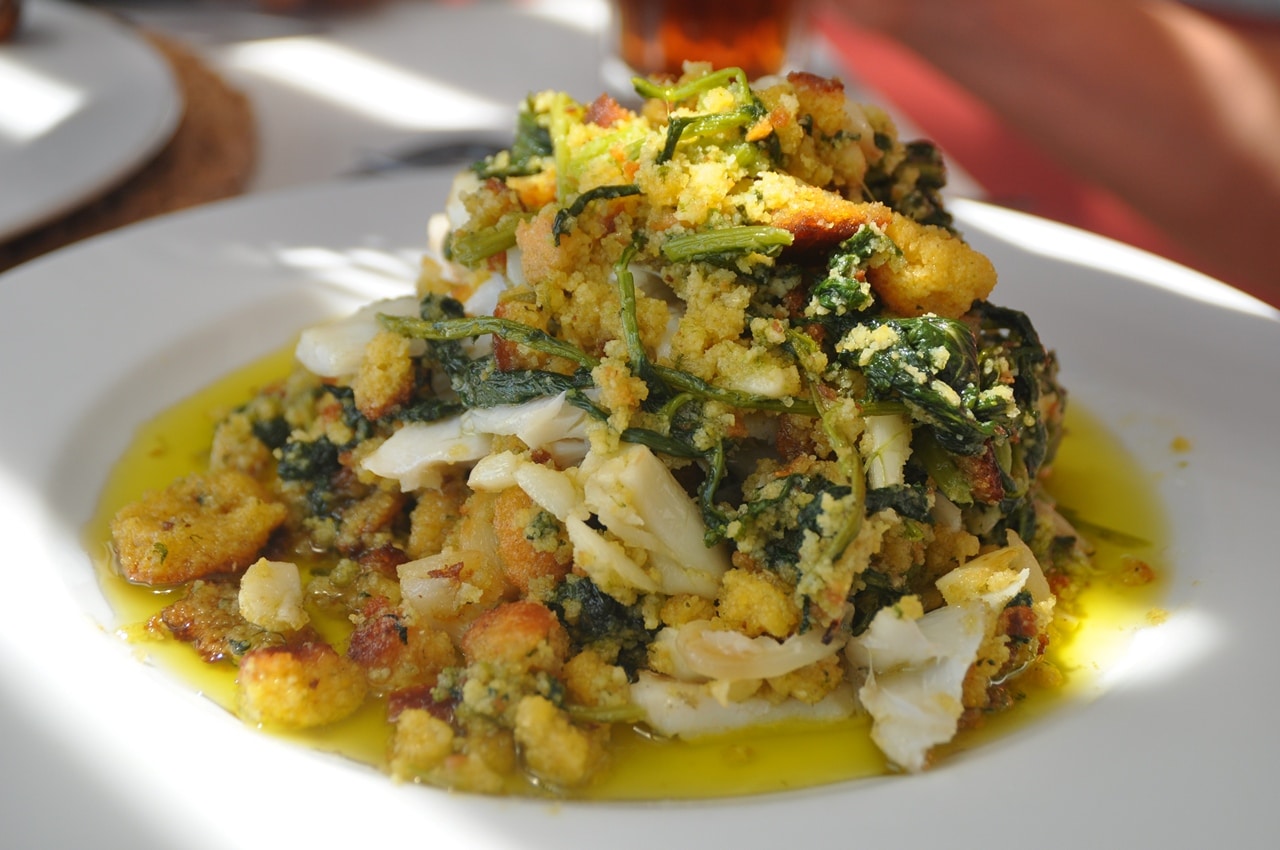
It is a fact that in more causal and neighbourhood/smaller towns restaurants portions can be huge. This doesn’t happen so much in medium range and above restaurants in larger towns, or top notch places where plates are made for a single person, but where you see that a restaurant has a half portion (Meia or ½ dose), go with that if you’re not a big eater. The half portion is intended for one and the full portion (dose) is meant for two people to share. And when going with a larger party and want to share a few dishes, especially if you order some larger appetizers like cheese and chorizo or some clams or octopus salad for example, go easy on the portions. Order one portion less than the number of people. 90% of times that will be enough food for everyone. Also when most restaurants claim the dish is for 2, many times it can serve 3.
Can I eat my greens?
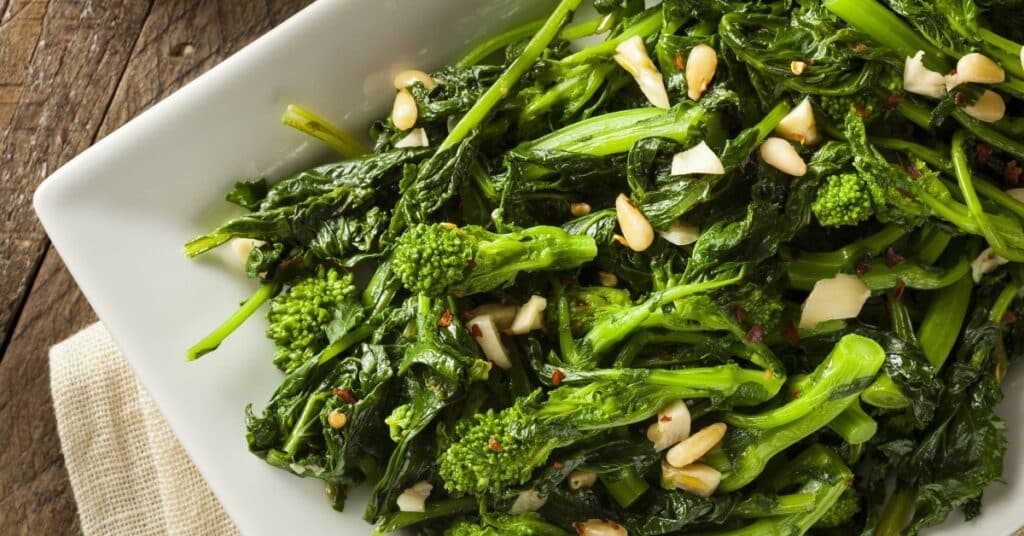
It is very common in menus throughout the country that the dishes only have the main protein or name of the dish and it’s your job to guess what it comes with. Fish dishes many times come with boiled potatoes and green beans or broccoli, and meat dishes, especially grilled ones are served with french fries, white rice (I know, I know…) and a small salad. And this is another thing worth mentioning. Our concept of salad as a side dish is not a huge bowl of several kinds of vegetables with some proteins mixed up. A mixed salad (salada mista) is lettuce and tomato. Sometimes you can get onion and/or cucumber but that is mostly it. And it is a small dish/bowl, made to be a side and not the main. So if you want more greens than this or more quantity, make sure to ask if they can make a larger salad or boil some vegetables instead of something else.
Did this fish just came out of the water?
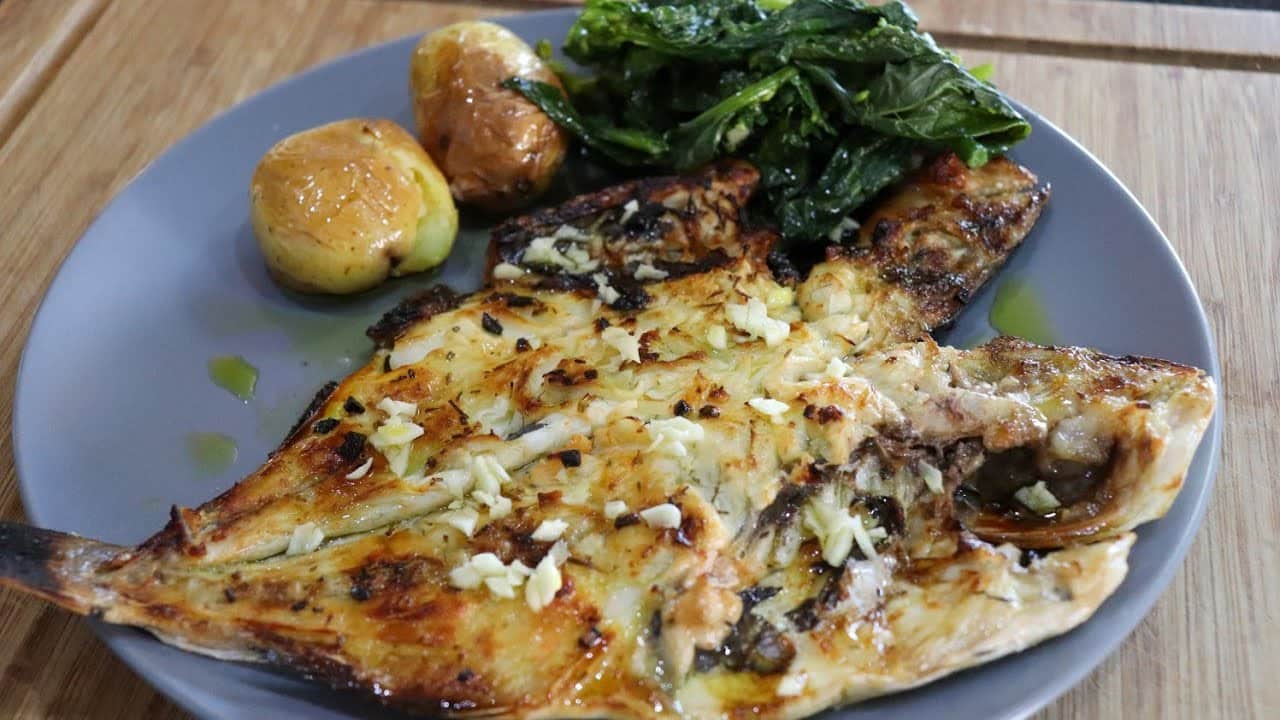
Well, in many places, yes, almost. It’s definitely one of the advantages of having such a huge coastline and a still quite traditional fishing industry is that everything is naturally very fresh. And while we’re talking about the fishing industry, let me tell you that the worst day to eat fish is Monday. Why? Because traditionally there is no fishing on Sunday and no Market on Monday so the fish you eat may be fresh, but it’s not of the day. This is also why you see many, many restaurants closing on Sunday and/or Monday. But another thing that comes with being very familiar with fish throughout the country is that the fish many times comes whole to your table. If it’s a small fish like Sardines or Mackerel it will just come on a platter as it was taken out of the sea and grilled. If it is a Sea bass or Bream it may come open in half but you have to take out the bones and go through it. Of course that if it is a larger fish like Cod or a Grouper you will get a slice of it. Only in higher end places is where they will filet the smaller fish and make a nicer presentation with it. Another thing that it is convenient to know is that when ordering fresh fish, it is normally stated that the price is per kilo. This is because not all fish weigh the same of course and a larger fish can serve two or three for example. So a kilo (2.2 pounds) is a lot for a person, but the fish is weighed whole, bones and also a fish for one will easily be around one pound or half a kilo. Have that in mind when ordering. It is also customary for the waiter to bring the fish to you and say “it’s xx kilos”, so you can agree or not on having that one, and you’ll know how much it will be.
What about drinks?
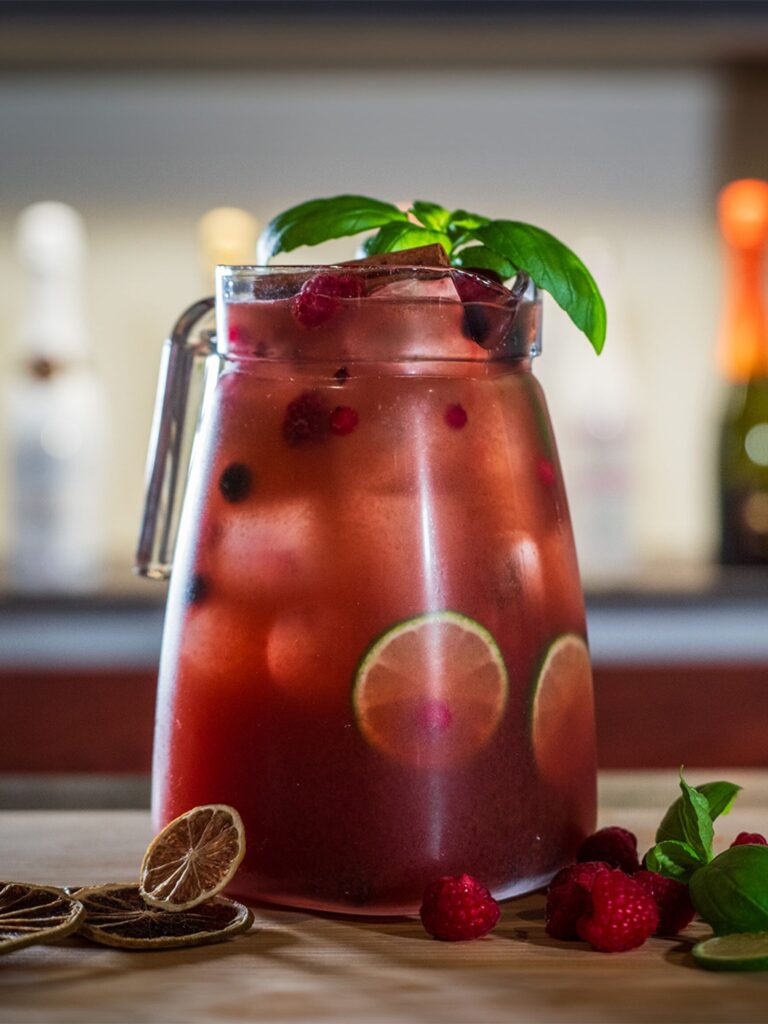
Drinks may be another item which causes some confusion. First because most places won’t ask you for the drinks before you order your meal, and secondly, because the options can be varied and somewhat different. One is that water is not free (as we said above, nothing is, right?), it’s only served when asked, and it comes in bottles, it is not customary to serve tap water, only bottled. Even if some places may have a jar with water for the clients use, they won’t serve it, you need to go and get it. And if you want it cold or with ice you need to ask for it, because many times it is served “natural”, that is, room temperature. One other difference is that many, many local places have what we call the “house wine” (vinho da casa). This is normally a quite inexpensive wine, which comes in a bottle sometimes but most times in a clay jar or carafe (1 liter or half a liter). It is definitely a very popular choice for an everyday meal here but also you will definitely be surprised with the quality of some of the wines you find throughout the country. The house wine is either red or white, sourced locally most times, and goes well with everything.
One of the local speciality wines is the green wine, not available as house wine in many places, but available in some, especially in the minho region. A young, light, slightly fizzy wine that goes very well with fish or shellfish on a hot summer lunch.
Many places will also have a version of Sangria. Sangria, while not being a Portuguese drink originally, it has become very popular and perfected in Portugal. You can have several versions, the most popular are red and white (made with red or white wine), but you can also have a red fruits version (wild berries, strawberries, etc) made with white wine or sparkling wine.
And of course that you can also find a variety of local and international beverages, sodas, flavoured waters, fruit juices, ice teas, etc.
After the meal ends, locals many times have coffee but there are some liqueurs or brandys that may appeal to you, from the very common Ginginha, a glass of Port, or the very local Licor Beirão (a mixture of herbs), or a local brandy (aguardente), aged or not. S. Domingos is a very popular white, non aged wine spirit, while Macieira or CR&F are two popular aged brandy’s. But there are many more, if you are into these drinks after the meal don’t be afraid to ask.
What if I’m Vegetarian, Vegan, Gluten free or have any other restrictions?
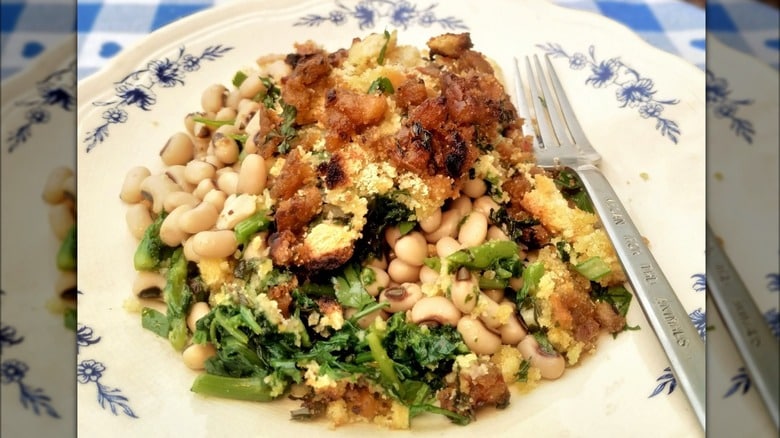
Well, it all depends on how many restrictions and how severe they are, but normally there are options for everyone. In the first place, the restaurants have to have a vegetarian option available. While this is true don’t expect very elaborate things in traditional restaurants, some greens with rice or potatoes, etc, but not much elaborate. But there are every year more and more places mostly in larger towns dedicated to vegetarian and also vegan food. So if this is the case, in the more central and touristy areas you’ll be fine. Also some international cuisines have naturally vegetarian dishes like Indian food for example and they are also present in many places. As for gluten allergies, many of the Portuguese dishes are naturally gluten free as we use many potatoes and rice so there won’t be an issue in many locations. The bread is definitely an issue and not a lot of places serve gluten free bread except in dedicated restaurants, but the rest of the meal will be ok. If your allergy is too severe and you need certified gluten free kitchens and all then you’ll need specific GF restaurants which also exist although naturally they are not many. One thing that helps is that many people with light allergies have been able to eat gluten products in Portugal and everything was ok. Not that you should try, you should evaluate your situation, but definitely some food allergies are less prevalent in Portugal.
One other thing that may come in handy especially if your allergy is very severe is to carry with you an allergy card, preferably translated also in Portuguese stating clearly what you cannot eat to hand to the waiters.
I finished already, why don’t I get my bill?
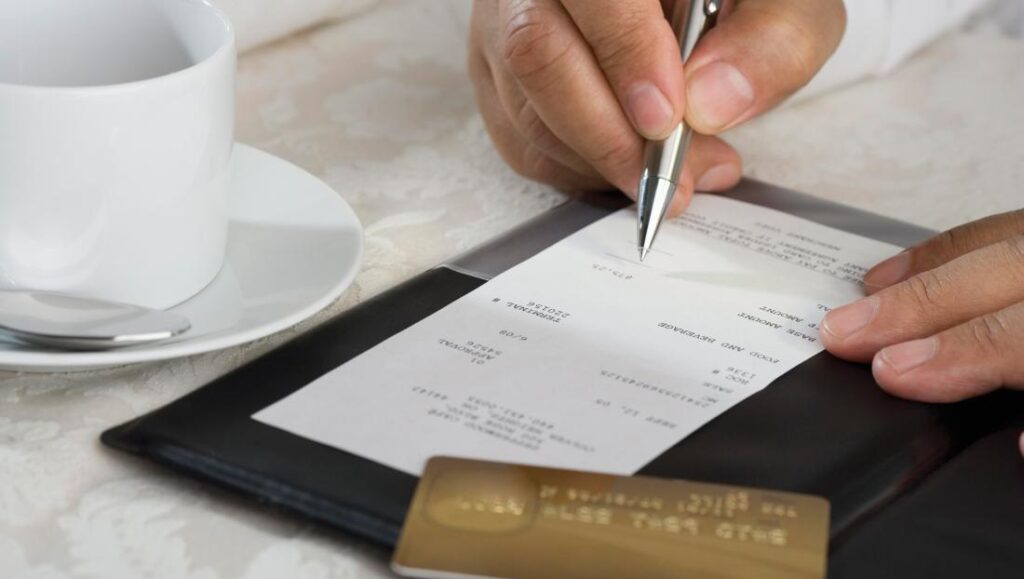
This is perhaps one major difference between what happens on this side of the Atlantic and in America or the United States. It is not uncommon for visitors to regard this as bad or sloppy service but it’s actually cultural. For locals it is quite rude for waiters to present the bill without being asked to. Meals are social events and people use them to chat and spend a good time with their friends. Even on a workday lunch, people tend to extend a bit the socialization part and there is nothing worse than a waiter shoving you a bill letting you know you’re not welcome anymore. So you have to actively ask for it, there is nothing wrong with that, and whey will bring it to you without any issue, but you do have to ask.
Now for the pain part, sorry, paying…

Actually this expression (painful) comes from a common trait in Portuguese where many people will ask for the bill as “a dolorosa”, which means literally the painful one. But how to pay it? Well, with a card you say. Naturally, but not always. It is important to know a few things. First, credit cards are not as frequent in Portugal as you may think. Mostly people use debit cards only and local businesses many times accept only local debit cards and not credit cards due to the fees. In touristy places you don’t see this, but in more local and rural areas yes. And American Express is not a widely used card in Portugal, so apart from hotels and more expensive touristy venues you won’t be able to use it. But what you will also see in many locations are places that don’t accept cards at all (normally very small hole in wall type of businesses) and also places that will not accept a card below 5€ or 10€. All these forms are legal if informed to the customer (normally there is a sign) and cash is still king, so be sure to carry at least some.
And What about tipping?
For that, read this other blog post about tipping: https://weekbreaktours.com/blog/how-does-tipping-work-in-portugal/
Hope these tips help you navigate your days in Portugal, leave a comment or remark if you liked the text.
At Week Break Tours, we specialize in crafting premium private tours that showcase the best of Portugal. Whether you’re looking for a cultural deep dive, a scenic road trip, or a gourmet adventure, we offer a wide range of customizable experiences tailored to your interests. Let us take care of the details while you enjoy a seamless, authentic, and unforgettable journey. Book your next discovery today!
Check our tours at www.weekbreaktours.com or Contact Us for more information.

 How does Tipping Work in Portugal?
How does Tipping Work in Portugal?